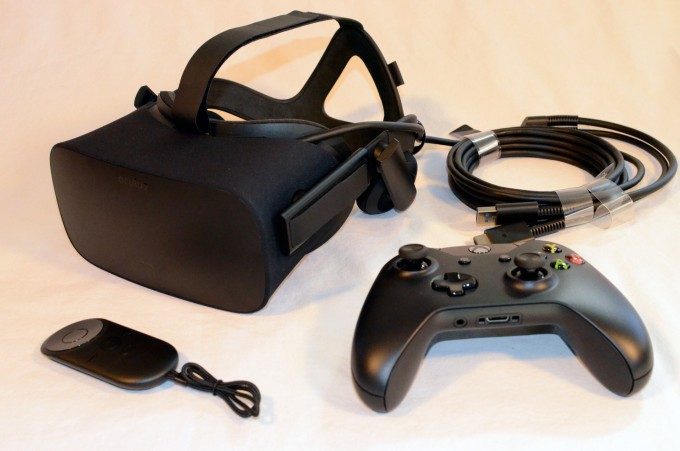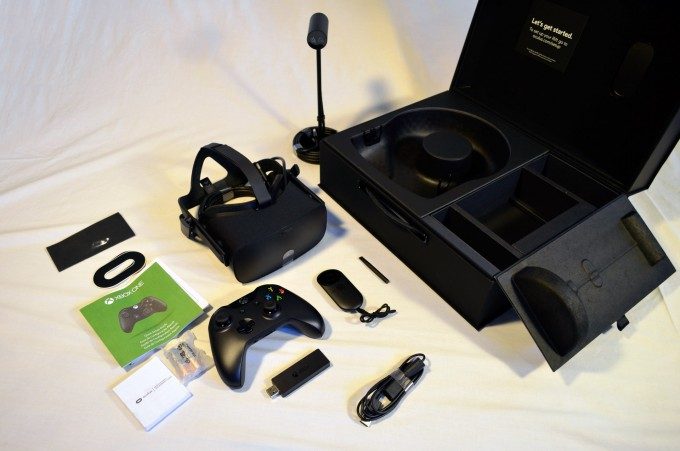The Oculus Rift is finally here and with it, the virtual reality industry steps from three consecutive years of ‘year zero’ to ‘year one’ for VR. There’s a lot riding on the Rift. Does it deliver?
I envy the person reading these words right now who has never tried virtual reality. While we (the VR community and industry) have waited for several years now for the first desktop-class consumer headset of this new VR era to launch, in your reality, VR has simply appeared, and in the form of a product that will almost certainly impress you.
The Oculus Rift launches today and after spending a week with the headset, we’re ready to give our thoughts.
Table of Contents
Hardware
Unboxing & Carrying Case
Oculus has gone full-Apple on the Rift unboxing and presentation. The headset ships inside of a svelte box which doubles as a carrying case. Upon opening, you’ll find the Rift, Sensor, Remote and an Xbox One controller. That’s pretty much it, save for a few little extras like an Oculus sticker and a lens wipe.
See Also: Unboxing the New Oculus Rift Step-by-Step in Pictures
The Rift carrying case holds the headset, Sensor, and Remote in a beautiful arrangement, almost as if it was made to be left open on display. The Rift carrying case is impressively well crafted, made out of what feels like thick cardboard covered with a velvety finish. The opening of the case clasps shut with magnets, and on top there’s a woven handle the feels plenty sturdy.
The case has already come in handy for repackaging the Rift to transport it from one place to the next. Combined with the simple set of components, those needing to move the Rift to and fro will be very happy with the case.
Design & Ergonomics
I’m confident in calling the Oculus Rift the most aesthetically pleasing headset among any that we know will launch in 2016. Oculus has gone to great length to meld form & function with the headset’s design.
While the company’s prior development kits felt like plastic bricks to attach to your face, the consumer Rift is elegant in its materials and design. Although it’s entirely black, it manages to feel welcoming, rather than project an appearance of a device only meant for hardcore gamers or tech nuts.
Fabric and soft plastics are used throughout. The main enclosure is rounded nicely and covered over with fabric except on the front. Inside, the lenses are surrounded by a flexible fabric that stretches with them as they move left and right when adjusting the IPD (the distance between the lenses, to correspond with the distance between your eyes) using a little dial on the bottom of the headset, which is the only button/control on the entire device.
Oculus says they designed the Rift for long-term comfort for lengthy sessions. And while in my experience they’ve achieve that goal, the unit can actually be quite uncomfortable if you aren’t very careful about tweaking the fit.
On the prior Rift development kits, a large portion of what held the headset on your face was the horizontal headstrap which squeezed the facial interface (the front part of the headset that touches around your eyes) with the back of your head. The consumer Rift is different, and if you carry your past practices of fitting the headset like the DK1 or DK2, you’ll be setting yourself up for discomfort.
The most critical adjustment for comfort on the consumer Rift is not how tight the side straps are, but instead getting the rear of the strap positioned correctly. You want the triangle on the back of the headset to be down very low, cupping the crown of your head. You want the weight of the headset to be mostly held up with the strap that goes over the top of your head, with it ultimately hanging down from that top strap with only a small amount of force from the side straps pulling the device against your face.
The best indicator I’ve found to make sure you have the right fit is that the struts protruding from the display housing should be parallel/square with the housing itself. If you see the struts tilted up or down at an angle, the headset is probably not adjusted optimally.
Unfortunately that means it’s difficult to find your fit while wearing the headset. There’s two straps on the right and left of the display housing, along with the top strap. Manipulating them all into their correct positions takes some practice, but it’s worth the time to get it right because once you do, the Rift can be very comfortable indeed.
Oculus said they’ve designed the headset so that once you find your fit, it’s easy to take off and put back on without additional adjustments. For the most part this is true and it’s achieved thanks to a spring system which allows the display housing to extend an extra inch or so when pulled (in the case of removing or putting on the headset), and then spring back to the same position of your original adjustment.
One annoyance with this system is that the tether cable—which comes out the top left of the display and then hooks onto the strap so that it falls behind your head and not next to it—causes the left strut to not spring as freely as the right side. This often causes the right strut to be fully extended on its spring while the left is not extended at all. When this happens the headphones then feel misaligned and, even after being adjusted to compensate, feel a like they’re resting against each ear differently. This annoyed me for a while, but I got over it quickly enough.
You can free up a little slack in the tether cable between the point where it enters the headset and the strap clip point to try to avoid this.
It was our understanding that Oculus would be shipping several foam “facial interfaces”—the foam that keeps the Rift on your face—in the box. However, the Rift only includes the single interface that it ships with. It’s removable, and Oculus tells us we can expect to see more down the road.
For now the company suggests a frame width of 142mm or less and a frame height of 50mm or less if you want to use glasses with the Oculus Rift



